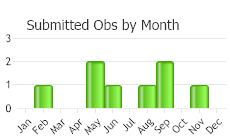View in other NatureServe Network Field Guides
NatureServe
Montana
Utah
Wyoming
Idaho
Wisconsin
British Columbia
South Carolina
Yukon
California
New York
Common Woodsy Plagiomnium Moss - Plagiomnium cuspidatum
Other Names:
Baby Tooth Moss
General Description
Plants: Acrocarpous (Vitt 1988), growing in open, frequently wide-spreading tufts (Crum and Anderson et al. 1981) or mats (Lawton 1971), green with yellow tones to deep green (Crum and Anderson et al. 1981). Fertile stems upright (Lawton 1971) and mostly 10-20 mm tall (seldom 35 mm); infertile stems sometimes reaching 70 mm (FNA 2014), spreading, creeping or arching and with radiculose tips (Crum and Anderson et al. 1981); rhizoids abundant at the stem bottom (Lawton 1971).
Leaves: Smaller and more distant below, wavy (Crum and Anderson et al. 1981), twisted, bent or curved when dry, plane (FNA 2014) and upright to spreading about 45 degrees when damp (Crum and Anderson et al. 1981), 3-5 mm in length (FNA 2014), 1-2 mm in width (Lawton 1971), obovate, occasionally elliptic (FNA 2014), ovate, or nearly circular (Lawton 1971), narrowing to an acumen or acute leaf tip with a long and occasionally-toothed cusp; base extending well down the stem and widely so; margins flat, sharply dentate in about the distal half; costa reaching or exceeding the leaf tip (FNA 2014).
Leaf Cells: Marginal teeth 1- or sometimes 2-celled; cells at the leaf edge arranged in 1 layer, long and thin, usually in 2-4 rows; medial laminal cells with length similar or longer than width, the cells smaller near the margins, occurring sometimes in up-and-down rows, seldom in oblique rows, nonporose (FNA 2014), the cell walls and angles thickened (Crum and Anderson et al. 1981).
Phenology
Fruit ripens in the last part of spring (FNA 2014).
Diagnostic Characteristics
Plagiomnium drummondii also has obovate leaves that are sharply dentate above, but it often has multiple setae, unlike P. cuspidatum (FNA 2014).
Plagiomnium rostratum and P. ellipticum also have teeth only in the upper part of their leaves; their teeth, however, are usually dull and not as large as those of P. cuspidatum (FNA 2014).
The variation of characters within and among populations of Plagiomnium makes identification difficult without fertile plants (FNA 2014).
Range Comments
North American Range
Canada: BC to NL and NS; USA: AK and nearly all continental states except unknown from ID to AZ; Mexico (FNA 2014). Known in Montana from Carbon, Carter, Flathead, Gallatin, Glacier, Lake, and Madison Counties (Elliott and Pipp 2016).
Observations in Montana Natural Heritage Program Database
Number of Observations: 8
(Click on the following maps and charts to see full sized version)
Map Help and Descriptions
Relative Density

Recency



 (Observations spanning multiple months or years are excluded from time charts)
(Observations spanning multiple months or years are excluded from time charts)
Habitat
Damp soil, humus, stone, rotting wood, fissures in bark; in wet woods and wooded peatlands with high-mineral content (FNA 2014). Occurring from low elevations to about 9840 feet (Lawton 1971).
Reproductive Characteristics
Archegonia and antheridia associating in the same bract cluster. Perigonial and perichaetial leaves to 6 mm (Lawton 1971). Seta solitary, 20-30 mm tall, occasionally reddish. Capsule 2-3.5 mm in length, drooping, with an obscure neck (FNA 2014), yellow to ochre; stomata sunken with guard cells only partially hidden; exostome teeth yellow with green tones, papillose; endostome segments more brownish, the keel widely perforate, with knobby cilia (Lawton 1971).
Stewardship Responsibility
References
- Literature Cited AboveLegend:
 View Online Publication
View Online Publication Crum, H.A. and L.E. Anderson. 1981. Mosses of Eastern North America. 2 volumes. Columbia University Press, New York. 1328 pp.
Crum, H.A. and L.E. Anderson. 1981. Mosses of Eastern North America. 2 volumes. Columbia University Press, New York. 1328 pp. Elliott, J.C. and A.K. Pipp. 2018. A Checklist of Montana Mosses (1880-2018). Updated 3 January, 2020. Montana Natural Heritage Program, Helena, Montana. 73 pp.
Elliott, J.C. and A.K. Pipp. 2018. A Checklist of Montana Mosses (1880-2018). Updated 3 January, 2020. Montana Natural Heritage Program, Helena, Montana. 73 pp. Flora of North America Editorial Committee, eds. 2014. Flora of North America North of Mexico. Volume 28. Bryophytes: Mosses, Part 2. Oxford University Press, Inc., NY. xxi + 702 pp.
Flora of North America Editorial Committee, eds. 2014. Flora of North America North of Mexico. Volume 28. Bryophytes: Mosses, Part 2. Oxford University Press, Inc., NY. xxi + 702 pp. Lawton, E. 1971. Moss Flora of the Pacific Northwest. Hattori Botanical Laboratory. Japan: Yamabuki-cho, Shinjuku-ku, Tokyo. 362 pages plus appendices.
Lawton, E. 1971. Moss Flora of the Pacific Northwest. Hattori Botanical Laboratory. Japan: Yamabuki-cho, Shinjuku-ku, Tokyo. 362 pages plus appendices. Vitt, D. J. Marsh, and R. Bovey. 1988. Mosses, Lichens & Ferns of Northwest North America. Seattle, WA: University of Washington Press. 296 p.
Vitt, D. J. Marsh, and R. Bovey. 1988. Mosses, Lichens & Ferns of Northwest North America. Seattle, WA: University of Washington Press. 296 p.
- Additional ReferencesLegend:
 View Online Publication
View Online Publication
Do you know of a citation we're missing? Elliot, J. C. 1993. Second checklist of Montana mosses. Unpublished report. U.S. Forest Service, Region 1. Missoula, MT. 45 pp.
Elliot, J. C. 1993. Second checklist of Montana mosses. Unpublished report. U.S. Forest Service, Region 1. Missoula, MT. 45 pp. Flowers, S. 1973. Mosses: Utah and the West. Brigham Young University, Provo, Utah. 567 p.
Flowers, S. 1973. Mosses: Utah and the West. Brigham Young University, Provo, Utah. 567 p. Lawton, E. 1971. Keys for the Identification of the Mosses on the Pacific Northwest. Reprinted from 'Moss Flora of the Pacific Northwest'. Published as Supplement No. 2 of the Journal of the Hattori Botanical Laboratory. Nichinan, Miyazaki, Japan. 66 pp.
Lawton, E. 1971. Keys for the Identification of the Mosses on the Pacific Northwest. Reprinted from 'Moss Flora of the Pacific Northwest'. Published as Supplement No. 2 of the Journal of the Hattori Botanical Laboratory. Nichinan, Miyazaki, Japan. 66 pp. Malcolm, B., N. Malcolm, J. Shevock, and D. Norris. 2009. California Mosses. Nelson, New Zealand: Micro-Optics Press. 430 pp.
Malcolm, B., N. Malcolm, J. Shevock, and D. Norris. 2009. California Mosses. Nelson, New Zealand: Micro-Optics Press. 430 pp. Smith, A.J.E. 1980. The Moss Flora of Britain and Ireland. Cambridge University Press, Cambridge. 705 pp.
Smith, A.J.E. 1980. The Moss Flora of Britain and Ireland. Cambridge University Press, Cambridge. 705 pp.
- Web Search Engines for Articles on "Common Woodsy Plagiomnium Moss"





